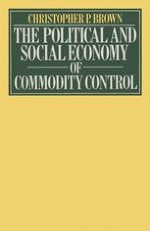1980 | OriginalPaper | Chapter
‘Commodity Power’ and the Commodities Dialogue
Author : Christopher P. Brown
Published in: The Political and Social Economy of Commodity Control
Publisher: Palgrave Macmillan UK
Included in: Professional Book Archive
Activate our intelligent search to find suitable subject content or patents.
Select sections of text to find matching patents with Artificial Intelligence. powered by
Select sections of text to find additional relevant content using AI-assisted search. powered by
The negotiations on individual commodity agreements which took place under the Integrated Programme tended to display less political posturing than the Common Fund dialogue discussed in the preceding chapters, to be attended by delegates and advisers relatively more familiar with commodity-market problems, and to be influenced more by economic as opposed to political bargaining positions. Often, however, developing countries sent political figures demanding political commitments to these meetings (e.g. Geneva mission personnel who, without technical advisers, represented their capitals in discussions of all commodities) at times when developed countries had despatched technical experts who were familiar with commodity markets and control but not with the sort of political gestures that the others sought. These two groups tended to talk past one another. As envisaged by the UNCTAD Secretariat, and subsequently adopted by the Group of 77, the ten core commodities (these were, in declining order of export value to developing countries: coffee, copper, sugar, cotton, rubber, cocoa, tin, tea, jute, and hard fibres) were to come under buffer-stock control by the end of the 1978.1 At the time that the Integrated Programme for Commodities was being put forward by its proponents, coffee was already controlled by an export-quota agreement, cocoa and tin by export-quota devices complemented by weaker international buffer-stock provisions, and sugar was seriously being considered for control by export quotas and national buffer stocks in a renewal of the 1968 Sugar Agreement.
